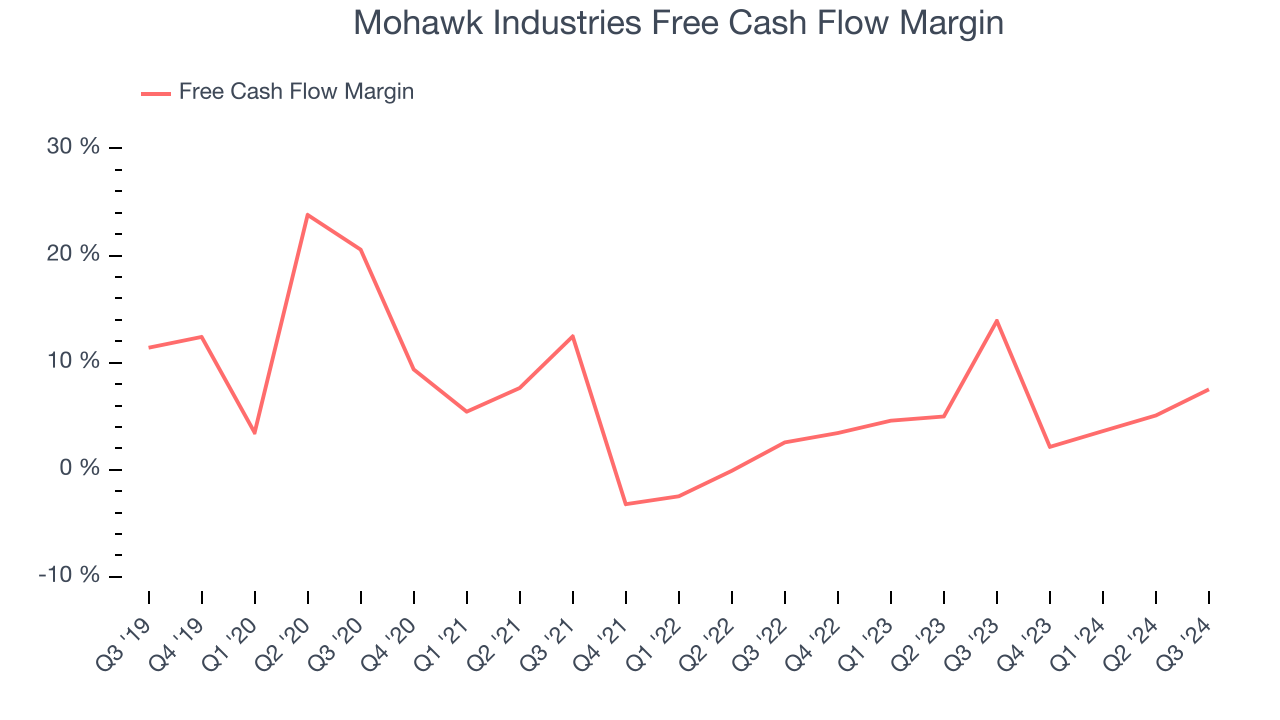Flooring manufacturer Mohawk Industries (NYSE:MHK) met Wall Street’s revenue expectations in Q3 CY2024, but sales fell 1.7% year on year to $2.72 billion. Its non-GAAP profit of $2.90 per share wasalso in line with analysts’ consensus estimates.
Is now the time to buy Mohawk Industries? Find out by accessing our full research report, it’s free.
Mohawk Industries (MHK) Q3 CY2024 Highlights:
- Revenue: $2.72 billion vs analyst estimates of $2.7 billion (in line)
- Adjusted EPS: $2.90 vs analyst expectations of $2.89 (in line)
- EBITDA: $392.4 million vs analyst estimates of $391.9 million (small beat)
- Adjusted EPS guidance for Q4 CY2024 is $1.82 at the midpoint, well below analyst estimates of $2.24 (management cited consumer confidence, inflation, and recent hurricanes as headwinds to demand)
- Gross Margin (GAAP): 25.5%, down from 26.6% in the same quarter last year
- Operating Margin: 7.8%, up from -26.5% in the same quarter last year
- EBITDA Margin: 14.4%, in line with the same quarter last year
- Free Cash Flow Margin: 7.5%, down from 13.9% in the same quarter last year
- Market Capitalization: $9.57 billion
Commenting on the Company’s third quarter results, Chairman and CEO Jeff Lorberbaum stated, “We delivered a solid performance in soft market conditions, which reflects the positive impact of our sales initiatives, productivity and restructuring actions as well as lower input costs, partially offset by pricing and mix pressure. Due to our increased earnings and management of working capital, we generated free cash flow of $204 million in the quarter, for a total of $443 million year to date. This year, we are investing approximately $450 million in capital projects focused on growth, reducing costs and asset maintenance.
Company Overview
Established in 1878, Mohawk Industries (NYSE:MHK) is a leading producer of floor-covering products for both residential and commercial applications.
Home Furnishings
A healthy housing market is good for furniture demand as more consumers are buying, renting, moving, and renovating. On the other hand, periods of economic weakness or high interest rates discourage home sales and can squelch demand. In addition, home furnishing companies must contend with shifting consumer preferences such as the growing propensity to buy goods online, including big things like mattresses and sofas that were once thought to be immune from e-commerce competition.
Sales Growth
A company’s long-term performance is an indicator of its overall business quality. While any business can experience short-term success, top-performing ones enjoy sustained growth for multiple years. Unfortunately, Mohawk Industries’s 1.6% annualized revenue growth over the last five years was weak. This shows it failed to expand in any major way and is a rough starting point for our analysis.

Long-term growth is the most important, but within consumer discretionary, product cycles are short and revenue can be hit-driven due to rapidly changing trends and consumer preferences. Mohawk Industries’s history shows it grew in the past but relinquished its gains over the last two years, as its revenue fell by 4.5% annually.
This quarter, Mohawk Industries reported a rather uninspiring 1.7% year-on-year revenue decline to $2.72 billion of revenue, in line with Wall Street’s estimates.
Looking ahead, sell-side analysts expect revenue to grow 1.6% over the next 12 months, an acceleration versus the last two years. Although this projection indicates the market believes its newer products and services will fuel better performance, it is still below average for the sector.
Today’s young investors won’t have read the timeless lessons in Gorilla Game: Picking Winners In High Technology because it was written more than 20 years ago when Microsoft and Apple were first establishing their supremacy. But if we apply the same principles, then enterprise software stocks leveraging their own generative AI capabilities may well be the Gorillas of the future. So, in that spirit, we are excited to present our Special Free Report on a profitable, fast-growing enterprise software stock that is already riding the automation wave and looking to catch the generative AI next.
Cash Is King
Although earnings are undoubtedly valuable for assessing company performance, we believe cash is king because you can’t use accounting profits to pay the bills.
Mohawk Industries has shown weak cash profitability over the last two years, giving the company limited opportunities to return capital to shareholders. Its free cash flow margin averaged 5.7%, subpar for a consumer discretionary business.

Mohawk Industries’s free cash flow clocked in at $204.2 million in Q3, equivalent to a 7.5% margin. The company’s cash profitability regressed as it was 6.4 percentage points lower than in the same quarter last year, but it’s still above its two-year average. We wouldn’t read too much into this quarter’s decline because investment needs can be seasonal, causing short-term swings. Long-term trends carry greater meaning.
Over the next year, analysts predict Mohawk Industries’s cash conversion will improve. Their consensus estimates imply its free cash flow margin of 4.6% for the last 12 months will increase to 7.7%, giving it more flexibility for investments, share buybacks, and dividends.
Key Takeaways from Mohawk Industries’s Q3 Results
We struggled to find many strong positives in these results. While the quarter's results were largely in line, guidance was well below, with management citing factors such as consumer confidence, inflation, and the recent hurricanes in the US. Overall, this was a softer quarter. The stock traded down 9.8% to $137 immediately after reporting.
Mohawk Industries’s latest earnings report disappointed. One quarter doesn’t define a company’s quality, so let’s explore whether the stock is a buy at the current price. We think that the latest quarter is only one piece of the longer-term business quality puzzle. Quality, when combined with valuation, can help determine if the stock is a buy. We cover that in our actionable full research report which you can read here, it’s free.
